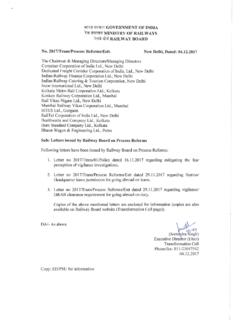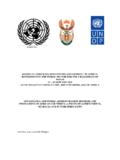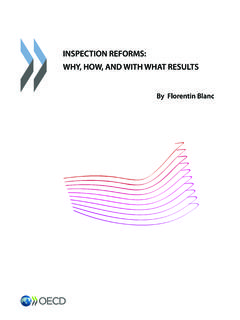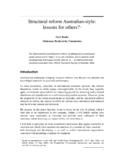Transcription of Basel Committee on Banking Supervision
1 Basel Committee on Banking Supervision Basel III: Finalising post-crisis reforms December 2017 This publication is available on the BIS website ( ). Bank for International Settlements 2017. All rights reserved. Brief excerpts may be reproduced or translated provided the source is stated. ISBN 978-92-9259-022-2 (online) Basel III: Finalising post-crisis reforms iii Contents Introduction .. 1 Standardised approach for credit risk .. 3 Internal ratings-based approach for credit risk .. 53 Minimum capital requirements for CVA risk .. 109 Minimum capital requirements for operational 128 Output floor .. 137 Leverage ratio .. 140 Basel III: Finalising post-crisis reforms 1 Introduction 1. This document sets out the Basel Committee s finalisation of the Basel III framework. It complements the initial phase of Basel III reforms previously finalised by the Committee .
2 The Basel III framework is a central element of the Basel Committee s response to the global financial crisis. It addresses a number of shortcomings with the pre-crisis regulatory framework and provides a regulatory foundation for a resilient Banking system that supports the real economy. 2. A key objective of the revisions in this document is to reduce excessive variability of risk-weighted assets (RWAs). At the peak of the global financial crises, a wide range of stakeholders including academics, analysts and market participants lost faith in banks reported risk-weighted capital ratios. The Committee s own empirical analyses highlighted a worrying degree of variability in the calculation of RWAs by banks. 3. A prudent and credible calculation of RWAs is an integral element of the risk-weighted capital framework. Banks reported risk-weighted capital ratios should be sufficiently transparent and comparable to permit stakeholders to assess their risk profile.
3 The Committee s strategic review of the regulatory framework highlighted a number of fault lines with the existing architecture, particularly the extent to which it adequately balances simplicity, comparability and risk sensitivity. 4. The revisions to the regulatory framework set out in this document will help restore credibility in the calculation of RWAs by: (i) enhancing the robustness and risk sensitivity of the standardised approaches for credit risk and operational risk, which will facilitate the comparability of banks capital ratios; (ii) constraining the use of internally-modelled approaches; and (iii) complementing the risk-weighted capital ratio with a finalised leverage ratio and a revised and robust capital floor. An accompanying document summarises the main features of these 5. In finalising these reforms, the Committee was guided by three overarching principles. First, the Committee is firmly committed to its mandate of strengthening the regulation, Supervision and practices of banks worldwide, with the purpose of enhancing financial stability.
4 A Banking system that is resilient will be able to support the real economy and contribute positively to sustainable economic growth over the medium term. 6. Second, the Committee actively seeks the views of stakeholders when developing standards. For these reforms, the Committee conducted an extensive consultation process with a wide range of stakeholders. The Committee thanks all stakeholders for their constructive contributions during this process. 7. Third, the Committee conducted a comprehensive and rigorous assessment of the impact of these revisions on the Banking system and the wider macro economy. As a result of this assessment, the Committee focused on not significantly increasing overall capital This is reflected in the design, calibration and transitional arrangements discussed below. The Committee will continue to monitor and evaluate the effectiveness of these reforms in reducing excessive RWA variability.
5 8. While the revised framework will continue to permit the use of internally-modelled approaches for certain risk categories (subject to supervisory approval), a jurisdiction which does not implement some or all of the internal-modelled approaches but instead only implements the standardised approaches is compliant with the Basel framework. More generally, jurisdictions may elect to implement more 1 The summary of the main features of the Basel III reforms is available at 2 The quantitative impact study is available at 2 Basel III: Finalising post-crisis reforms conservative requirements and/or accelerated transitional arrangements, as the Basel framework constitutes minimum standards only. Implementation dates and transitional arrangements 9. The Committee is introducing transitional arrangements to implement the new standards to ensure an orderly and timely implementation by jurisdictions and adjustment by banks.
6 The main implementation dates are provided in the table below. Revision Implementation date Revisions to standardised approach for credit risk 1 January 2022 Revisions to IRB framework 1 January 20223 Revisions to CVA framework 1 January 2022 Revisions to operational risk framework 1 January 2022 Leverage ratio Existing exposure definition: 1 January 20184 Revised exposure definition: 1 January 20225 G-SIB buffer: 1 January 2022 Output floor 1 January 2022: 50% 1 January 2023: 55% 1 January 2024: 60% 1 January 2025: 65% 1 January 2026: 70% 1 January 2027: 3 On implementation of the revisions to the risk-weighted framework outlined in this standard and the revised output floor, the scaling factor that applies to the RWA amounts for credit risk under the IRB approach will no longer apply. More specifically, the references to the scaling factor in paragraphs 14 and 44 of the Basel II framework (June 2006), and paragraphs 49, 88, 90 and 91 of the revised securitisation framework (July 2016) will no longer apply.
7 4 Based on the January 2014 definition of the leverage ratio exposure measure. Jurisdictions are free to apply the revised definition of the exposure measure at an earlier date than 1 January 2022. 5 Based on the revised leverage ratio exposure measure set out in this document. Basel III: Finalising post-crisis reforms 3 Standardised approach for credit risk Introduction 1. The Committee permits banks to choose between two broad methodologies for calculating their risk-based capital requirements for credit risk. The first, the standardised approach, assigns standardised risk weights to exposures as described in paragraphs 4 to 97. To determine the risk weights in the standardised approach for certain exposure classes, in jurisdictions that allow the use of external ratings for regulatory purposes, banks may, as a starting point, use assessments by external credit assessment institutions that are recognised as eligible for capital purposes by national supervisors, in accordance with paragraphs 98 to 116.
8 Under the standardised approach, exposures should be risk-weighted net of specific provisions (including partial write-offs). 2. The second risk-weighted capital treatment for measuring credit risk, the internal ratings-based (IRB) approach, allows banks to use their internal rating systems for credit risk, subject to the explicit approval of the bank s supervisor. 3. Securitisation exposures are addressed in the securitisation Credit equivalent amounts of OTC derivatives, exchange traded derivatives and long-settlement transactions that expose a bank to counterparty credit risk2 are to be calculated under the counterparty credit risk Equity investments in funds and exposures to central counterparties must be treated according to their own specific 1 The securitisation standard is available at 2 Counterparty credit risk is defined as the risk that the counterparty to a transaction could default before the final settlement of the transaction s cash flows.
9 An economic loss would occur if the transactions or portfolio of transactions with the counterparty has a positive economic value at the time of default. Unlike a firm s exposure to credit risk through a loan, where the exposure to credit risk is unilateral and only the lending bank faces the risk of loss, counterparty credit risk creates a bilateral risk of loss: the market value of the transaction can be positive or negative to either counterparty to the transaction. The market value is uncertain and can vary over time with the movement of underlying market factors. 3 The counterparty credit risk standards are set out in Annex 4 of the Basel II framework (June 2006), amended to reflect the changes set out in: (i) Basel III: A global regulatory framework for more resilient banks and Banking systems (June 2011), available at ; (ii) The standardised approach for measuring counterparty credit risk exposures (April 2014), available at ; and (iii) Capital requirements for bank exposures to central counterparties (April 2014), available at 4 Standards on capital requirements for banks equity investments in funds are available at ; and for capital requirements for bank exposures to central counterparties are set out in Section XI of the counterparty credit risk standards.
10 4 Basel III: Finalising post-crisis reforms A. Individual exposures Due diligence requirements 4. Consistent with the Committee s guidance on the assessment of credit risk5 and paragraphs 733 to 735 of the Basel II framework (June 2006), banks must perform due diligence to ensure that they have an adequate understanding, at origination and thereafter on a regular basis (at least annually), of the risk profile and characteristics of their counterparties. In cases where ratings are used, due diligence is necessary to assess the risk of the exposure for risk management purposes and whether the risk weight applied is appropriate and The sophistication of the due diligence should be appropriate to the size and complexity of banks activities. Banks must take reasonable and adequate steps to assess the operating and financial performance levels and trends through internal credit analysis and/or other analytics outsourced to a third party, as appropriate for each counterparty.

















